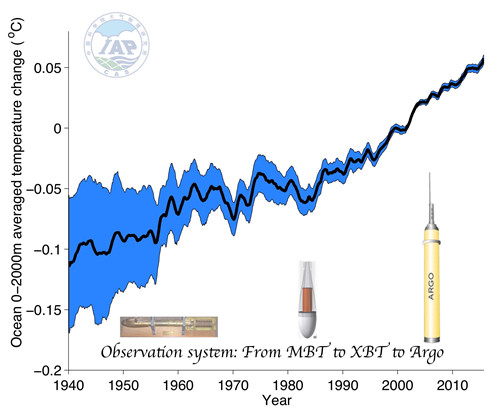IAP Releases a New Gridded Ocean Temperature Dataset for 1940-2015
Date:2016-07-25
A complete map of the ocean subsurface temperature is essential for monitoring aspects of climate change such as the ocean heat content (OHC) and sea level changes and for understanding the dynamics of the ocean/climate variation. The major international ocean data centers have released several widely used gridded datasets, for instance, EN data by Met Office of United Kingdom, Ishii data by Japan Meteorological Agency, WOD data by national oceanic and atmospheric administration (noaa) of United States of America, and many Argo based datasets in recent decade (i.e. IPRC, SCRIPPS). However, there are large discrepancies among those datasets, especially in the research surge of “climate hiatus”: different datasets lead to different results in tracking ocean heat flow. The key is to identify the error in reconstructing the ocean subsurface temperature field, and then solve the identified problem.
In the Pre-Argo era, global observations have not been available, so a gaps-filling strategy (or mapping method) is required to fill the data gaps. The spurious long-term signals in many historical datasets are sourced from the bias in the mapping methods. Therefore, an advanced mapping method, that is able to minimize the analysis error, is highly preferred for the climate community.

0-2000m averaged ocean temperature change as seen in IAP-Gridded dataset, from 1940 to 2015. (Image Credit: CHENG Lijing). The Argo icon is from IMOS website.
An advanced mapping method is proposed by CHENG Lijing and ZHU Jiang from Institute of Atmospheric Physics (Cheng&Zhu, 2016), to reconstruct the historical ocean subsurface temperature field by using ensemble optimal interpolation with a dynamic ensemble (EnOI-DE) approach and a multimodel ensemble of phase 5 of the Coupled Model Intercomparison Project (CMIP5) historical and representative concentration pathway 4.5 simulations.
The new mapping strategy is motivated by the deficiencies in some of the available methods, as follows: (1) the choice of climatology (zero-anomaly) as the first-guess leads to an over-reversion of the OHC estimate toward zero, and (2) the parameterized error covariance is empirical, which assumes the same spatial correlation over the global ocean, might not be accurate enough to represent the anisotropy of the covariance in the ocean. Based on this motivation, our new strategy uses an ensemble of CMIP5 models to provide the first-guess field and error covariance and shows better performance in reconstructing the historical ocean subsurface temperature field.
A careful evaluation indicates that the ocean mean state, long-term trends, inter-annual and decadal variability are all well represented in the new data (Figs. 1-4). The detailed description of the method and its evaluation is recently published in Journal of Climate.
Besides, a new study (Trenberth et al. 2016) led by NCAR scientists provides an assessment on Earth’s energy imbalance from multipule sources, including OHC change based on ocean gridded dataset (IPRC, SCRIPPS, EN4.1, JAMSTEC77, IAP). Results indicate that the monthly observational OHC tendencies show non-physical fluctuations, suggesting large (spurious) noise on month-to-month scale. Nevertheless, the IAP dataset shows the smallest noise among the six observational estimates.
The resolution of the IAP new dataset is 1o×1o, within 1m to 2000m (41 layers), and monthly data from 1940 to 2015. The data is available at http://159.226.119.60/cheng/
References:
1. Cheng L. and J. Zhu*, 2016, Benefits of CMIP5 multimodel ensemble in reconstructing historical ocean subsurface temperature variation, Journal of Climate, 29(15), doi: 10.1175/JCLI-D-15-0730.1.
2. Trenberth K, K., J. Fasullo, K. von Schuckmann, L. Cheng, Insights into Earth’s energy imbalance from multiple sources. Journal of Climate. doi:10.1175/JCLI-D-16-0339, in press.
3. Cheng L., J. Zhu*, R. Cowley, T. P. Boyer and S. Wijffels, 2014: Time, probe type and temperature variable bias corrections on historical expendable bathythermograph observations. Journal of Atmospheric and Oceanic Technology, 31(8), 1793-1825. http://journals.ametsoc.org/doi/abs/10.1175/JTECH-D-13-00197.1
Contact: Dr. CHENG Lijing, chenglij@mail.iap.ac.cn
